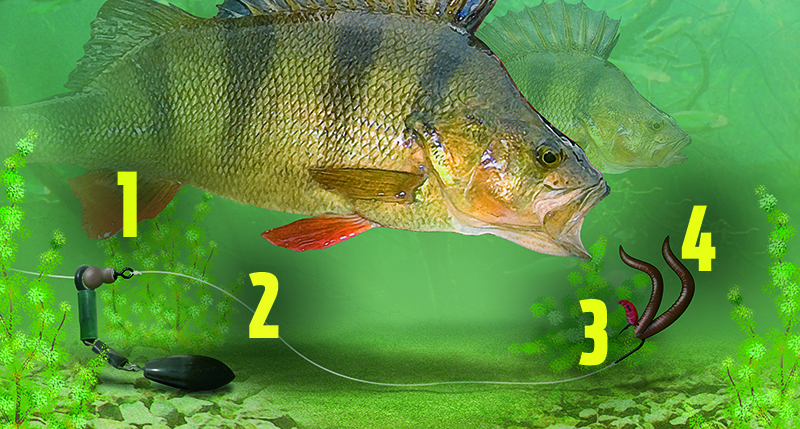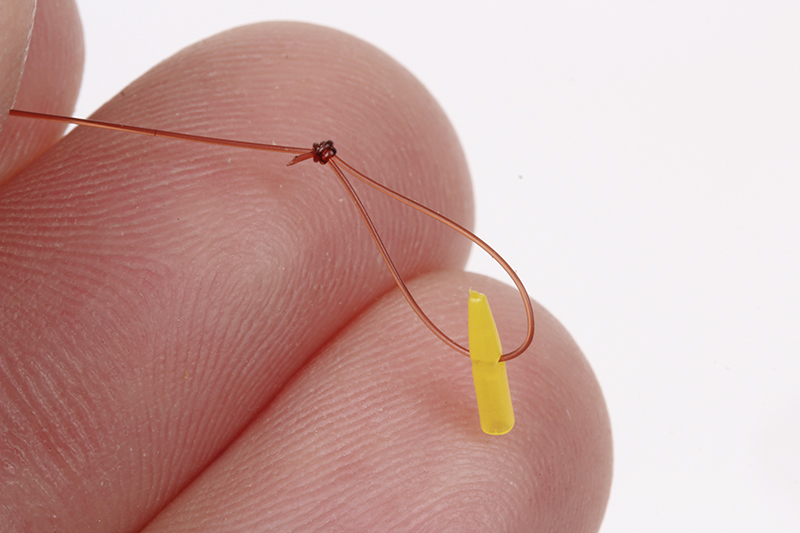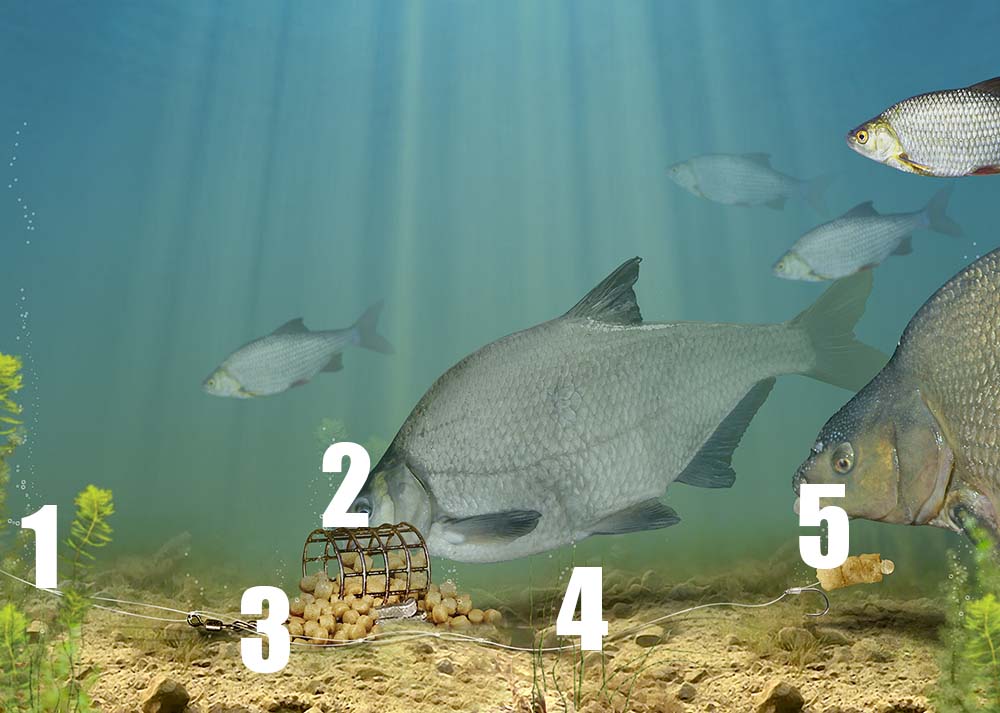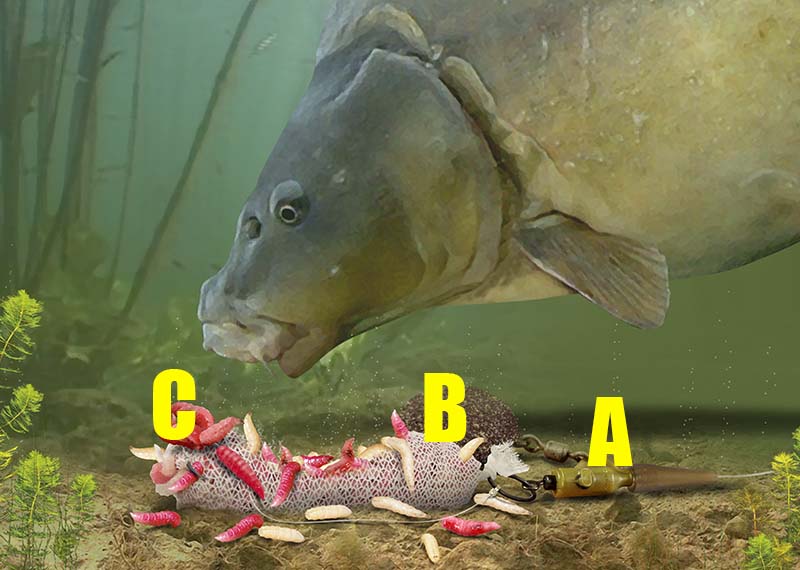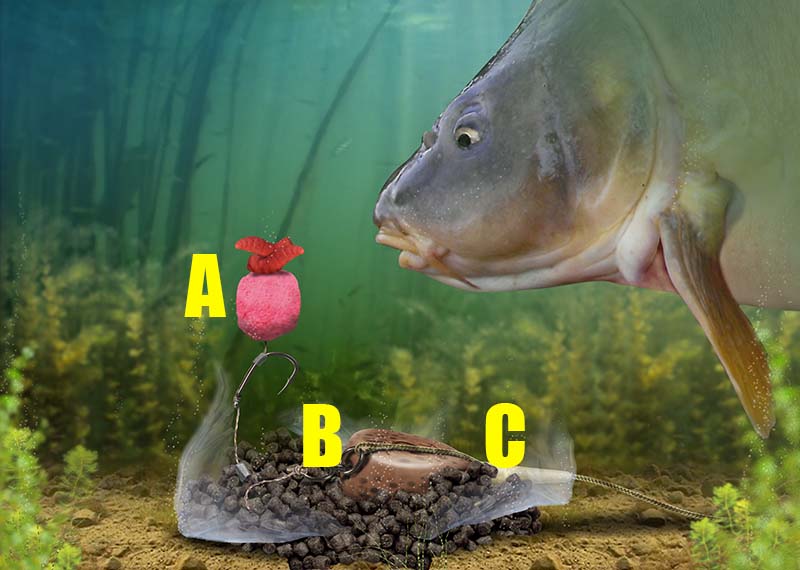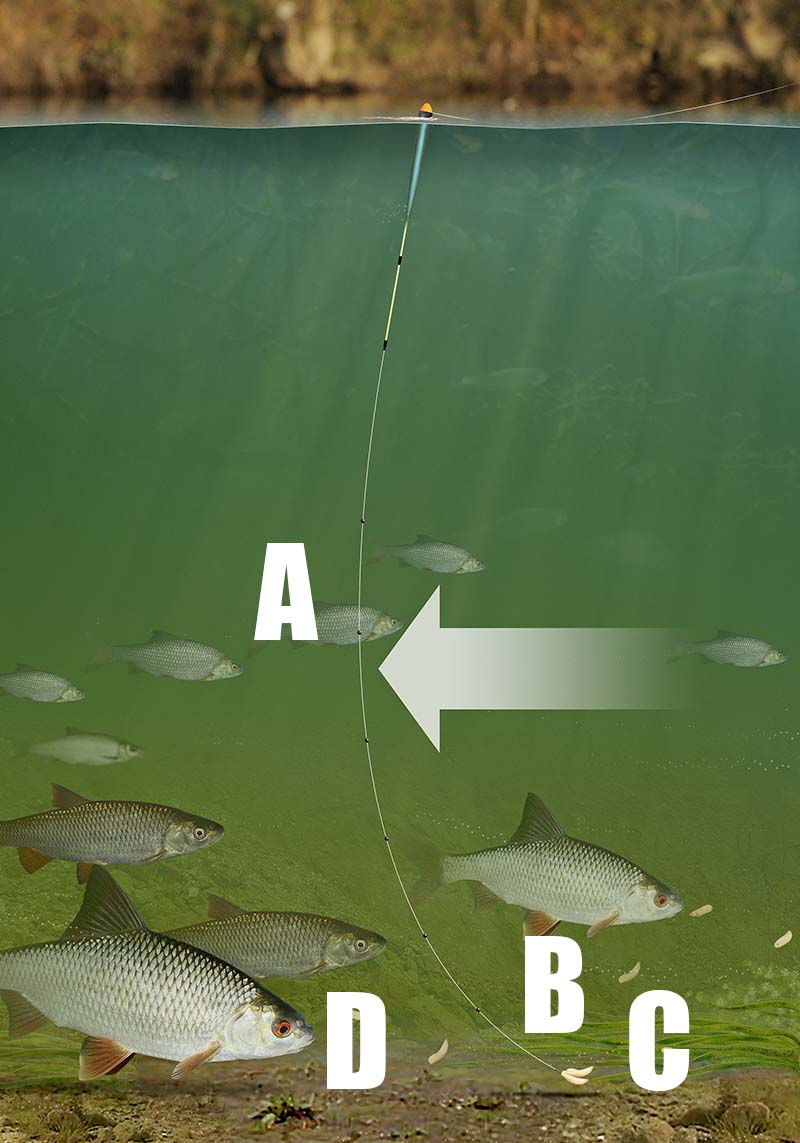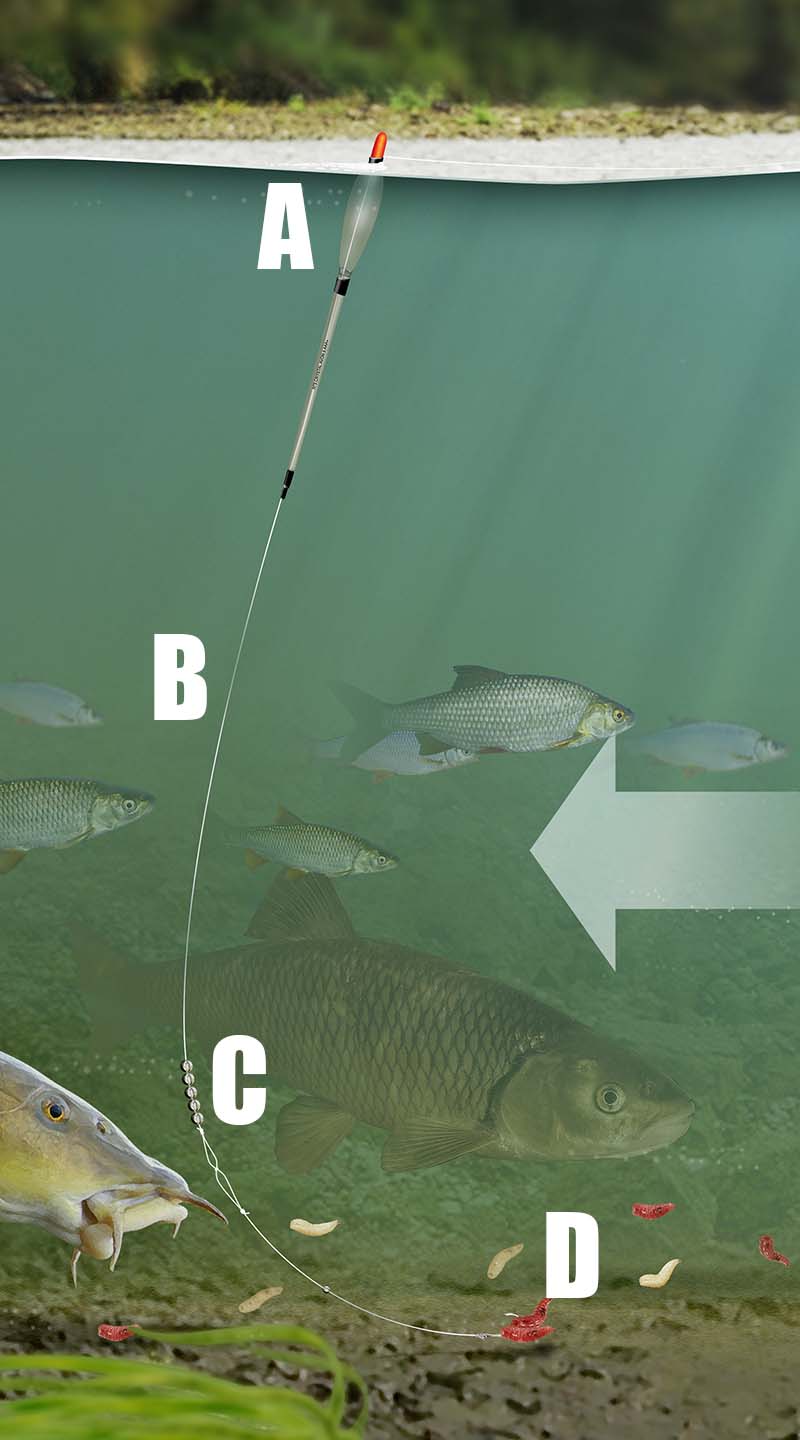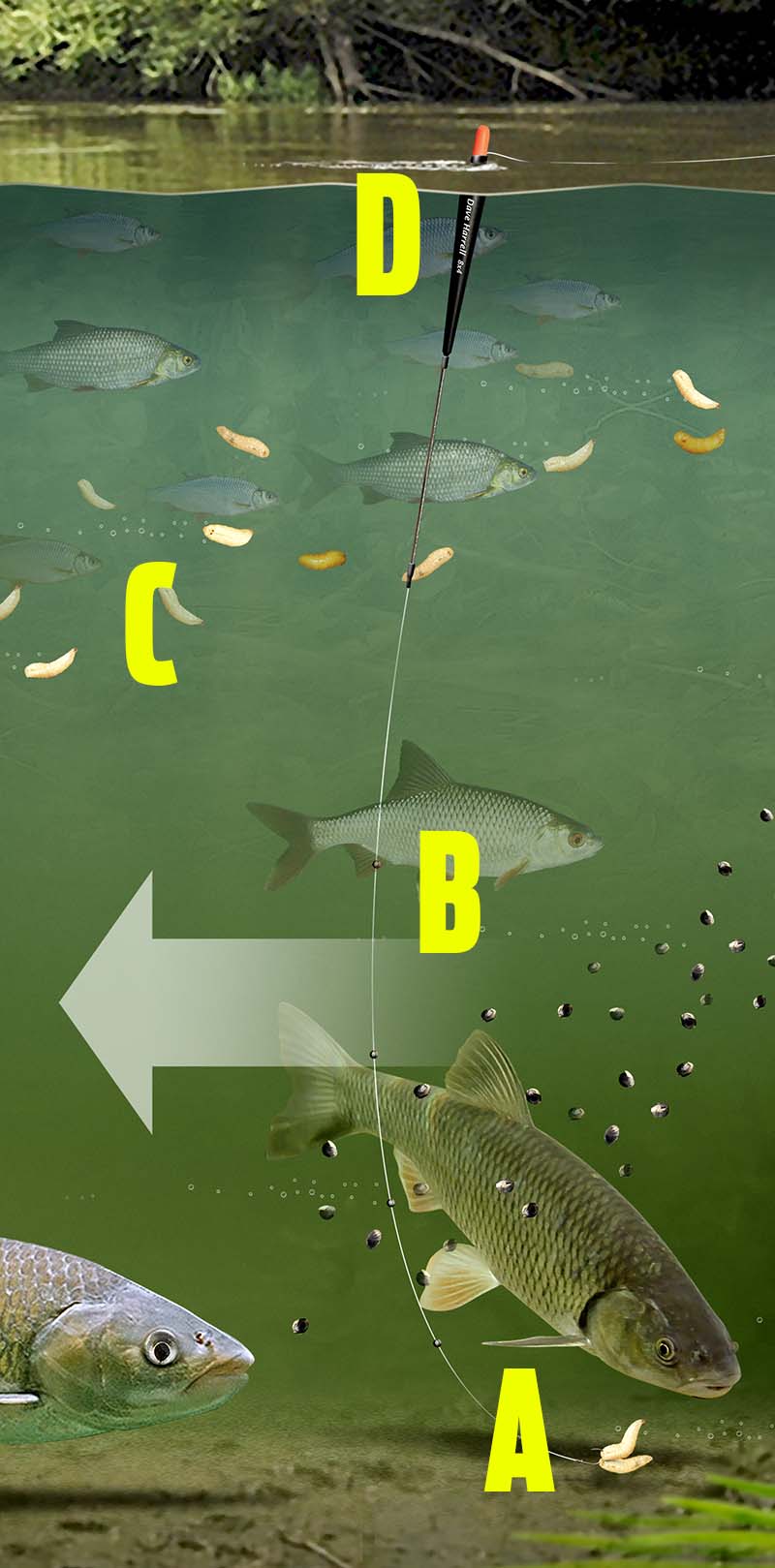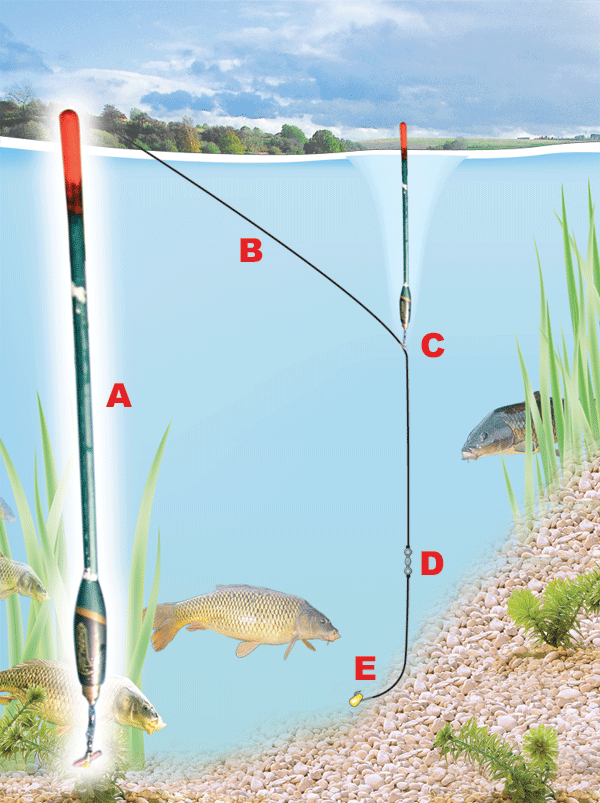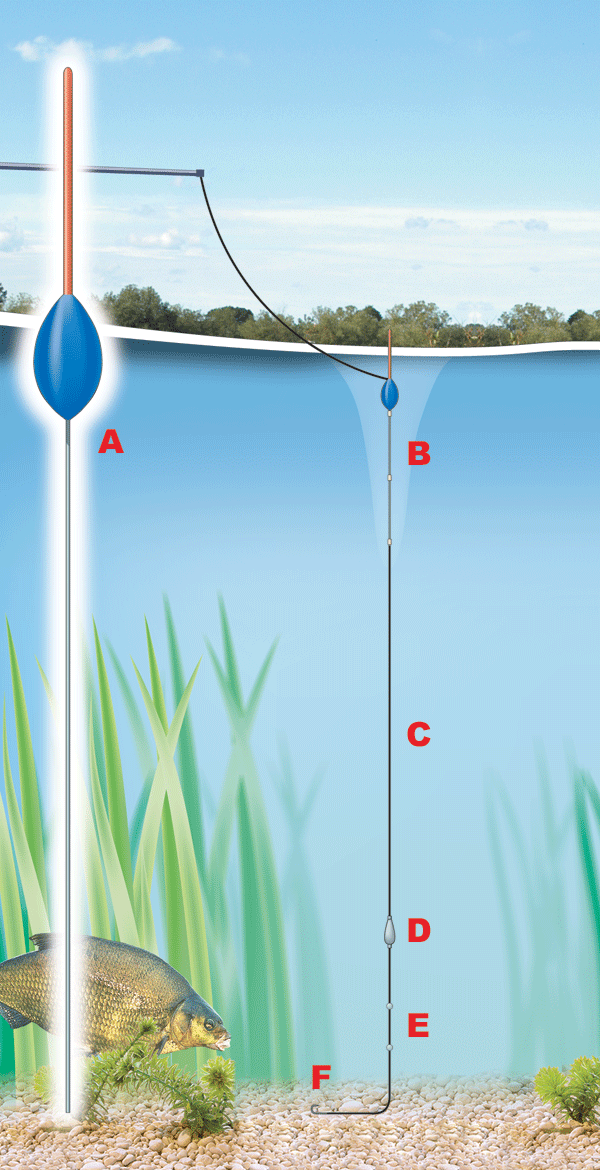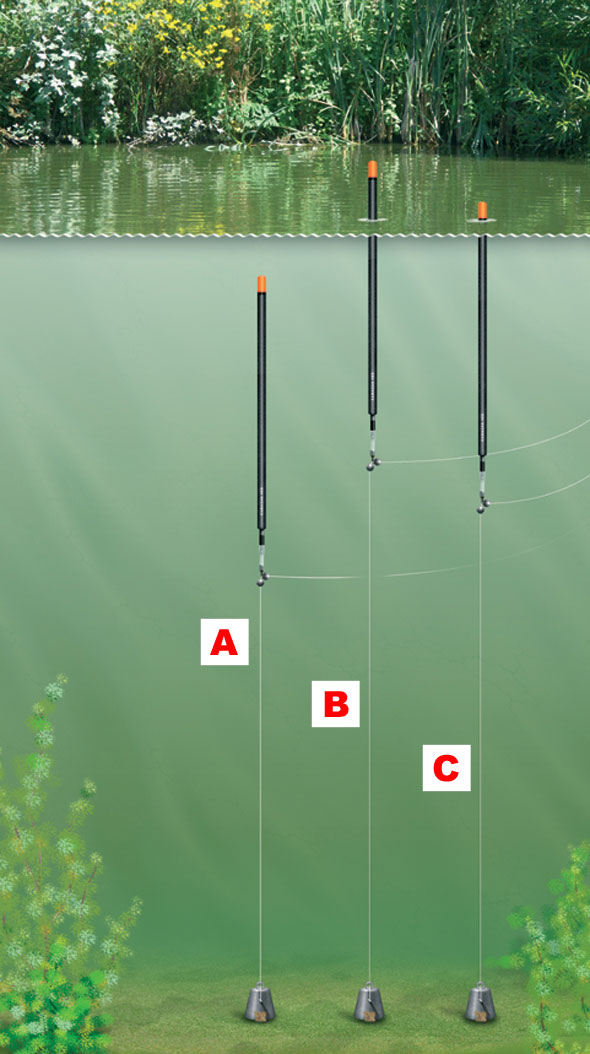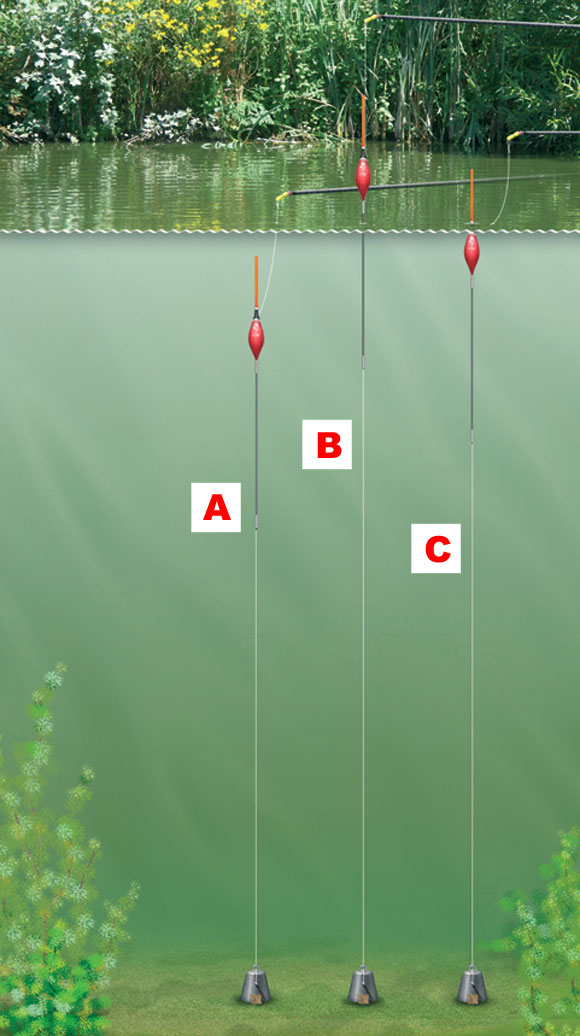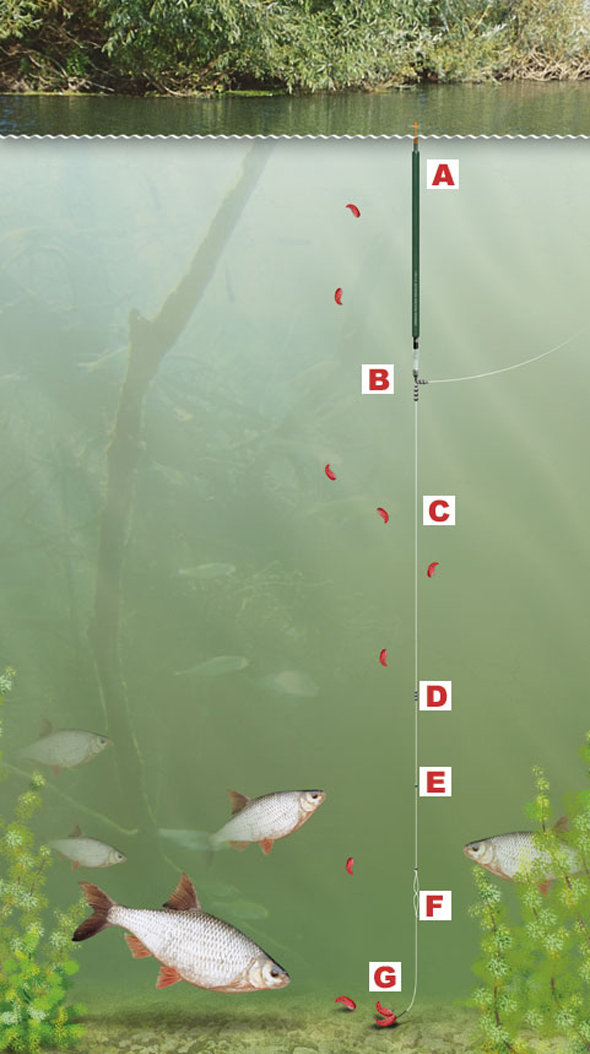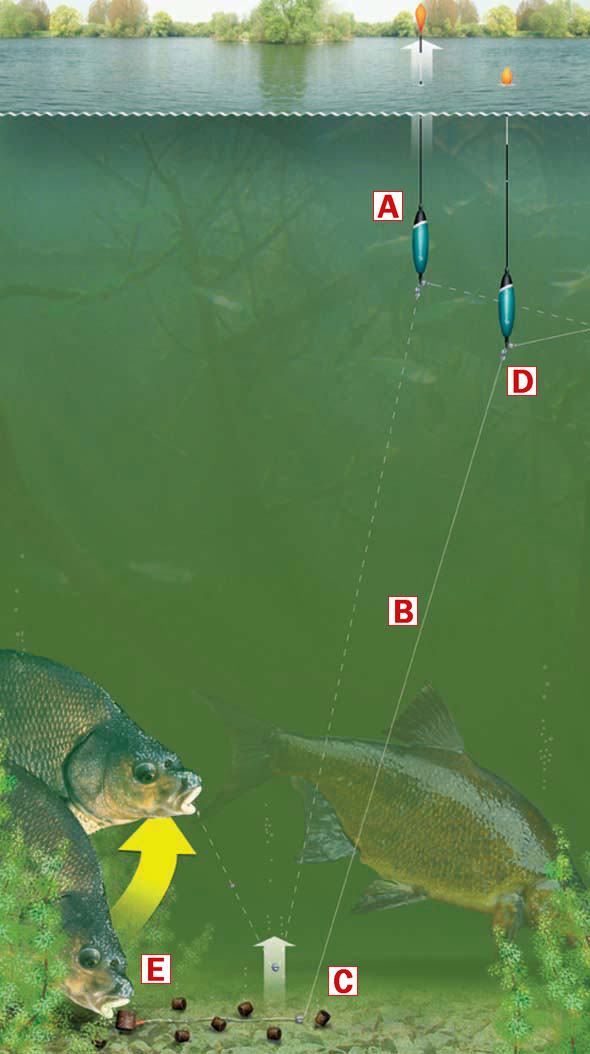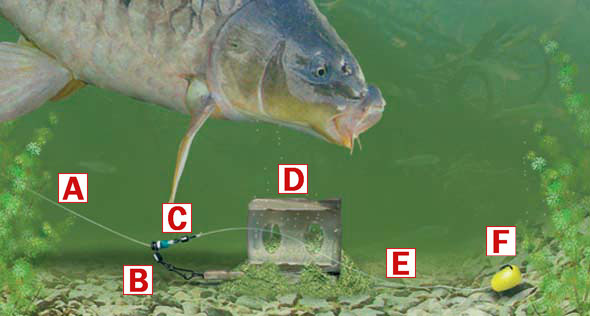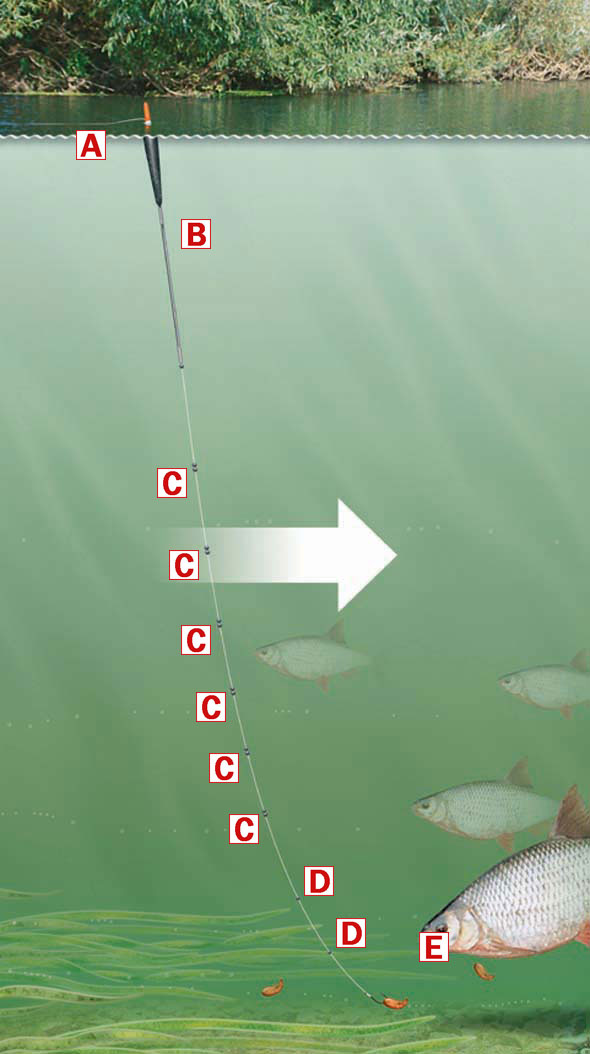PERCH FISHING RIG | How to tie a perch float rig
You will need...
• 3AA bodied waggler
• 5lb mainline
• 4lb hooklength
• Size 10 Nash Fang Uni hook
Here’s a precisely set-up float rig to eliminate the resistance perch hate, which also has the benefit of working well for targeting even larger species
Perch are very obliging fish that can be caught in many different ways, but one of the finest has to be on float-fished worm or prawn.
These larger baits help to deter small fish from picking up your bait giving you a good chance of latching on to a larger than average specimen.
Perch do not like a moving bait, so it is much better to nail it to the lakebed by fishing slightly overdepth with a small shot to anchor the float in position.
Having plenty of shot down the line also helps to keep the rig in place and stop it from being moved around.
Perch bites are normally very bold, but with this rig you can shot the float down so that only the tip is showing when the No.4 shot rests on the bottom.
Should you cast out too far, the shot will not be on the bottom and the float will disappear, telling you that you need to fish a little closer. This rig will also work well for other larger fish – bream, tench and carp.
1. Lock the float in position with two BB shot. These shot should not be pinched on too hard, so they can be moved to adjust the depth once you start fishing
2. The bulk of the shot, made up of several BBs is positioned at just over half depth. This group of shot will get the hookbait down quickly and give the rig stability
3. Tie a double overhand loop knot in the end of the mainline. The loop should be about 2cm in length. The hooklength will later be attached to this
4. Cut off 45cm of 4lb clear line to make the hooklength. It is important to use a hooklength that is lighter than the mainline in case you need to pull for a break
5. Tie a size 10 hook on to the hooklength using a spade-end knot that has first been passed through the eye. This is a very strong knot, ideal for hook with large eyes
6. Next, tie a simple double over-hand loop in the end of the mono hooklength. The hooklength should ideally be about 20cm in length once finished
7. Add a No.4 shot 12cm above the hook. When setting the depth ensure that this shot is on the bottom to secure the hookbait in place
Large baits such as lobworms help to pick out the bigger perch in your swim
How to tie | The bomb and worm rig
Worms – no perch angler would fish without them, and while the species will take a bait that’s drifting past them, when fishing to cover a static bait gets much better results.
Perch will tuck themselves under trees or close to snags, waiting for prey fish to go past, so popping a big lobworm right in front of them is an invitation too good to refuse.
A whole lobworm is a good, active bait, but two tail sections can be even better, as the broken worms give off attractive natural juices that spread through the water. Fish them on a size 8 hook with a simple running set-up using an Arlesey bomb – one of Dick Walker’s own inventions for tackling the lake of the same name – and a long tail of modern fluorocarbon line.
Feeding in this sitation is hard, but if you want to add some pices of chopped worm, make a few casts with a blockend feeder instead of the bomb.
1) free-running set-up
This streamlined lead is fished on a running rig comprising the bomb on a link swivel to a run ring. It’s topped by a tulip bead pushed into the swivel carrying the hooklink.
2) Arlesey bomb
This streamlined lead was developed specifically for perch fishing by Dick Walker for distance casting on deep lakes, but is now the go-to lead for many other scenarios.
3) Red maggot teaser
Two lobworm tails on a size 8 wide gape hook are the perfect medicine for specimen perch, but why not tip the bait off with a single red maggot for that extra bit of movement?
4) big bait for big perch
Perch do not chomp down on prey like pike, but ‘inhale’ it – and there’s not much their capacious mouths can’t take in. Two big lobworm tails will deter the smaller stripeys.
Top five lures for perch fishing with Sam Edmonds
After the pike, perch and zander have spawned they will be ready to go on a feeding spree. so here are my top five lures that i use when going after perch and zander in spring.
Shad (Berkley Ripple Shad 5cm and 7cm)
The Ripple Shad has a thick paddle tail, and ribs running along the body, which produce lots of vibration when the lure is retrieved – ideal for fishing in coloured canals.
Plastic worm (Berkley Floating Mice Tail)
A plastic worm that works well on a drop shot rig, nose-hooked on a size 6-8 hook. Brown is a great all-round colour, but brighter pink and white lures are great in coloured water.
Crankbait (Berkley Frenzy Flicker Shad Suspending 5cm)
This crankbait dives to around 5ft, great for fishing shallow canals. It covers lots of water quickly, searching out fish, and an internal rattle adds to the enticing action.
Shad (Berkley Powerbait Shrug Minnow 1.5ins)
Rigged on a 1.5g or 2.5g jighead, I use this tiny shad for smaller perch and zander, but it works for big fish too. Orange Glow is a great colour but Cherry Red is a close second.
Twitchtail (Berkley Twitchtail Minnow)
Available in many colours, this is my favourite soft bait for rigging on a drop shot rig to target big perch, but is also great for zander. I like to nose-hook these on a size 2 Owner Mosquito drop shot hook.
How to Hair rig worms!
This subtle but clever variation on the typical hair rig enables you to fish more effectively with soft baits such as worms
Legering with worms, especially the more delicate lobworms, can be tricky if you need to fish at range with a heavy weight. Sometimes the worm can be smashed off the hook as it hits the water, or the worm may wriggle free or even mask the point.
All of these problems can severely reduce your catches, so a solution that holds the bait better and lessens the risk of bites being missed is important, especially for specialist anglers.
Normal hair rigs are great at hooking fish, but with soft baits, such as worms, they are less effective as often the bait is lost. This led to this variation on the normal hair rig which incorporates two small discs of foam to cushion the bait on the cast. A Quick Stop is used instead of a normal boilie stop, so there is no chance of the stop being lost when a worm tries to wriggle free.
Another advantage is that this rig works just as well with barbless hooks, as you are not reliant upon the barb to hold the bait in place. This makes it ideal for many commercial fisheries. So, if you are intending to leger worms for carp, tench, bream or perch then give this rig a try to see how effective it can be.
how to tie
Step 1)
Attach a Quick Stop to the end of a length of 6lb hooklength using a simple overhand knot
Step 2)
Leaving a hair of about 15mm, tie on a size 10 hook using a 10-turn knotless knot
Step 3)
Tie a size 10 ring swivel to the other end of the hooklength, which should be 20cm long
Step 4)
Use a lead clip and tail rubber to attach a 1.5oz swivel lead to the mainline
Step 5)
Tie hooklength swivel to mainline using a four-turn grinner knot, then pull lead clip over the swivel
Step 6)
Cut two 2mm thick slithers of rig foam. The round foam sticks give the neatest finish
Step 7)
Thread a small disc of rig foam on to the hair using a Quick Stop needle, followed by a lobworm and then a second small piece of foam
How to tie the Carolina Rig
A: The action of the nose cone hitting against the glass bead on the retrieve makes a tapping noise which can induce a take
B: The leader section enables the lure to flutter to the lakebed under its own weight, which can encourage more bites
C: Because the hook point sits flush to the back of the lure, it is impossible for it to snag up in weed
When faced with a weedy river swim this lure set-up is almost impossible to snag up and is great for big perch....
Originally developed by bass anglers in the USA, the Carolina Rig has proven just as deadly for perch on this side of the Atlantic.
Designed to fish a soft plastic ‘creature’ bait close to the bottom and among thick weed, the Carolina rig has the great advantage that it is almost snagless.
This is because of the special wide gape offset hook that is used, and which are now available from several specialist lure outlets in the UK.
With the hook sitting flush with the top of the bait, this rig can be fished amid plants and sticks with little chance of snagging.
The Carolina rig is fished with a slow lift- and-drop retrieve that enables the soft plastic bait to wiggle enticingly as it moves forward and then flutter weightlessly down as the retrieve is paused. This action is very effective for perch and can also be used for zander too.
While drop shotting is rightfully very popular, other tactics such as the Carolina rig are great alternatives and well worth adding to your repertoire.
HOW TO TIE IT
1. Cut off a 24-inch length of 8lb fluorocarbon line to make the hooklength. Hold on to both ends and pull to straighten the line
2. Tie on the offset hook using a four-turn grinner knot. With fluorocarbon, only one pass through the eye of the hook is required
3. Tie a mini swivel to the other end of the hooklength using a four-turn grinner knot. Wet with saliva before pulling tight
4. Slide a 10g-15g bullet weight on to the mainline braid and follow with an 8mm glass bead. Tie braid to the swivel with a four-turn grinner
5. Thread the hook through the head of your creature bait and then back through the body so that the hookpoint lays flat against the back
6. A striking fish pushes the hook through the bait exposing the hookpoint, yet the lure will glide effortlessly through snags and weed
Rig for floatfishing close to islands and features
This float rig is ideal when casting tight to an island to catch the carp that patrol around its margins. As you will be casting to a feature you can actually use this rig with the line clipped up because a hooked fish will not be able to swim away from you - it can only swim to the side or towards you.
A Use a loaded, bodied float that is attached to the line with a fixed float adaptor. Alternatively a couple of tiny split shot will suffice. The best float to use is a straight bodied waggler because they pop up to the surface very quickly, ready to detect a bite straight away.
B Mainline needs to be strong enough to cope with carp and the problem of hooked fish reaching any snags. We suggest using no lighter than 4lb.
C Make sure that the depth is plumbed accurately so that the rig is set cotrrectly and that the bait touches the bottom.
D By using a swivel to link the mainline to the hooklength esnures that a replacement hooklength can be attached quickly, and as this rig will be cast a lot of times, the hooklength will not spin up as the bait revolves when it is being drawn back to the bank.
E Ideal hooklengths for this rig need to be 0.14mm and above. The best baits for this style of fishing are either sweetcorn, maggots, casters or a piece of worm.
The best pole rig for fishing with chopped worms
This simple pole rig is perfect for fishing with chopped worm for a number of reasons - it's stable so the bait remains still, it pushes the bait to the bottom quickly to avoid smaller bait-snatching fish, and it is perfect for lifting and lowering the bait to entice a bait.
A A rounded or body-down pole float is ideal for this rig. They can be held back against any surface tow well, in windy conditions.
B Always attach your pole float using three silicone strips of tubing to ensure it does not slide along the line.
C Mainlines and hooklengths for this rig should be quite strong as you may encounter tench or carp when fishing with chopped worm. A mainline of 0.14mm tied to a 0.12mm hooklength will suffice.
D Using an olivette around 10in from the bottom will ensure that the bait is forced through the depths quickly, straight past any smaller fish that may snatch at the bait as it drops. Olivettes also help steady the rig in adverse conditions.
E Use two dropper shot equally spaced between the olivette and the hook. No8 or No10 shot are ideal for this as they are light enough to provide a slow, gentle and natural drop of the bait through the final 20 inches of water.
F Fish your bait around 3-5in overdepth, and remember to use a strong hook. One of the best for chopped worm fishing is a Kamsan B711.
Resistance-free running rig for big perch
This is THE rig to use if you are targeting specimen perch. Although it’s quite simple to tie, the components you will need are quite specialised but can be bought from all good tackle shops.
A Run Ring is a must because this provides a large diameter bore through which the line passes, therefore resistance is kept to a minimum. Big perch will drop a legered bait if they feel the slightest resistance.
The Run Ring will need covering with some silicone tubing to prevent tangles, and then a snap link swivel can be clipped to the Run Ring so that any weight of lead can be used quickly and easily.
The best hooklength lines should be soft, supple and camouflaged – either a braid or clear mono is ideal. Length needs to be between 2ft and 4ft.
One of the best baits for big perch is a couple of lobworms, so this means that the hook will need to be quite large. A size 4 wide gape will be ideal, preferably barbed so that the worms remain on the hook.
A Use a Run Ring followed by a bead and a swivel. The Run Ring reduces the amount of resistance to the taking fish.
B The size and weight of lead ought to suit the distance that you intend casting. You could switch the lead for a feeder crammed with red maggots or chopped worms if you wish.
C It’s best to incorporate a snap link swivel into this rig so you can change the lead quickly at any stage during the session.
D Use a large swivel and a very strong knot to lock on your hooklength as there’s every chance you may encounter a large tench, carp or bream fishing with this rig.
E Hooklengths need to be strong and short – 2ft to 4ft is ideal and between 4lb and 8lb is best.
F When fishing with two lobworms hook them in the saddle with a wide gape size 4 hook.
G Chop and change your baits between using whole lobworms and broken lobworms to find out which bait the fish respond to best.
How to plumb the depth when floatfishing a waggler
Close in
Hold the plummet in one hand and your rod in the other – flex the tip of the rod slightly by pulling the line taught. Open the bail arm of the reel. Swing the rod upwards, let go of the plummet and take your finger off the spool to cast the plummet into the swim. Timing and a smooth motion is crucial, so do it very slowly to begin with to gain practice. Casting the plummet in this fashion minimises the disturbance it causes when it hits the water – but you can cast it overhead just like you would a float if you can’t master this way.
At distance
Pinch an SSG weight onto your hook (inset). Cast it into the swim in an overhead fashion. As long as the SSG is enough to sink your float it will take it out of sight if you are too shallow. When you can only see the fluorescent part of the float, it is set at a dead depth.
A. This shows you are too shallow.
B. This shows you are slightly too deep.
C. This shows you are just on the bottom.
How to find the depth when pole fishing
Plumbing and finding the depth of the lake, canal or river when pole fishing is a lot easier than finding the depth when you're float fishing because you can simply lower the plummet into your swim and gently drop it onto various areas of the swim to gain a true picture of the venue's depth.
It's a vital part to a successful session as it will give you a true picture of what's under the water and therefore give you a great insight into where you should be feeding and placing your bait.
You can also use your plummet to locate any underwater obstacles too by gently 'swinging' the plummet through the swim to see if it becomes lodged against anything that's submerged.
Here's how to go about finding the depth on your pole line...
STEP 1
Pass your hook through the eye in the plummet
STEP 2
Secure your hook into the cork in the base of the plummet.
STEP 3
Lower the plummet into the swim below the end of your pole.
STEP 4
Add a section of pole at a time and plumb around the swim, lowering the plummet straight down, not at an angle, to ensure an accurate reading of the swim.
STEP 5
Once you have got the exact depth of the swim, hook your hook into the base of your pole top kit. This will pull the elastic out slightly and secure your rig. With Tipp-Ex, mark the point where the top and the bottom of your float sit against the pole. This means you always have a point to refer back to should you change the depth you are fishing during the day.
A. This shows the float is set too shallow
B. This shows the float is set too deep
C. This shows the float is set perfect
Simple waggler rig to catch fish overdepth
This is a simple, straightforward waggler rig that will catch fish from stillwaters, canals and rivers. It’s the basic float rig that every angler ought to know how to tie.
The float is locked onto the line using a silicone float adaptor (these allow a quick change of float whenever required) and is locked in place using the vast majority of shot either side of the adaptor.
You’ll find the number and sizes of shot needed to cock the float printed on the side of the float. This will give you a guideline as to the amount of shot needed.
Next place a few much smaller dropper shot just below mid-depth (a few No6 or No8 shot will ideal).
After this place another two or three No8 shot equally spaced between the last shot and the hook. These will provide a slow and gentle fall of the bait through the last few inches of water.
You will need to plumb the depth really carefully so you know how deep to set the rig, and aim to set the rig 4-6in overdepth so that the bait settles on the bottom.
Most fish feed on the bottom, so this is a good place to start presenting your bait.
A Add enough shot to the rig so that your float’s sight tip just breaks the surface.
B Use a silicone float adaptor to attach the float onto your line, and lock the float in place using the vast majority of shot.
C Your strength of line needs to match the species of fish you are likely to catch. For small fish use between 2.5-4lb, and for carp use between 4-8lb.
D This group of No6 or No8 shot need placing just below mid-depth.
E Spread two or three No8 shot equally between the last group of shot and the hook.
F Your hooklength needs to be slightly weaker than the mainline so if a breakage occurs, it will occur here and not on your main rig.
G Aim to present your baited hook on the bottom at the start of the session as it’s here that most fish will feed. Present the bait between 4-6in overdepth at the start.
How and when to use a Driftbeater float rig
Want to be able to keep your float rig still when fishing a large windswept lake? Well here’s the rig for you – the simple driftbeater rig. When fished correctly this rig can be used to anchor your bait to the bottom in the strongest of undertows.
It works by placing a fairly large shot overdepth, so that it rests on the bottom. This helps hold the rig in place far better than a standard waggler rig fished overdepth ever would.
Driftbeater floats are a little specialised items of fishing tackle so not all tackle shops sell them, unfortunately. They are a bodied waggler having a very long and slender stem that leads to a bulbous balsa sight tip. No other float looks like a driftbeater.
You will need to plumb the depth accurately when using a driftbeater rig, as you have to place a shot far enough down the line so it rests on the bottom.
Here’s how to make the rig:
A Shot the float so that only the body is submerged. Don’t worry that there is 8ins of the stem sticking out the water – you’ll rectify this when you are fishing with the rig properly.
B Your mainline will need to match the species you are catching. A good starting point will be around the 3-4lb mark. Also, sinking mainlines are better as the line will cut through the surface tension and sink, preventing it from being pulled across the water surface in the wind.
C Find the depth of the swim using a plummet, then add another 12ins to the length of the rig. Now place a substantial split shot 8ins from the hook. A No1, or in extreme conditions a BB shot, would be ideal.
D After casting, allow the bottom-most shot to settle on the bottom, then sink your rod tip and wind it a few turns to sink the line between rod and float. Place your rod in rests with the rod tip submerged and slowly turn the reel’s handle until the float sinks to its sight tip. It is now ready to register a bite. Although there are times when the float will be instantly pulled under, most bites will lift the float right out the water.
E Remember to use a hook to match the size of the bait you are fishing with.
How to tie a resistance-free running feeder or leger rig
The resistance-free running rig has to be one of the simplest leger and feeder rigs a fisherman ought to know how to tie, and it’s deadly too. It will work on rivers, lakes and canals, for almost all British freshwater fish, and below you'll find out how to tie it...
This rig can be used with a groundbait feeder, a blockend feeder or a straight lead, and it can be used with a very short hooklength or a really long one – the choice is yours.
This rig is ideal as it allows the angler to swap and change the weight, style of type of leger/feeder being used in seconds. You simply unclip the Feedabead or snap link swivel and swap the feeder/leger over. This is handy if you need extra weight to cast through a wind. Maybe you’ve fed enough and want to switch to a smaller feeder. Or perhaps you want to search the water for signs of fish and wish to switch to a straight lead – you can do it all with this rig.
Here’s how to tie it…
A Your mainline needs to be strong enough to cope with the fish you are likely to catch. An average day on an average stillwater will require 4-6lb line.
B Thread a Korum Feedabead or snap link swivel onto your mainline and follow this with a small bead.
C Now securely tie on a micro swivel. Micro swivels are tiny and therefore they weigh very little, so a fish that takes the bait won’t be able to feel the weight of this tiny swivel.
D Clip your chosen weight onto the Feedabead or snap link swivel. It could be a groundbait feeder, a blockend feeder or a straight lead.
E Your hooklength choice will again depend upon the size of fish present in the venue. The best hooklengths are high-tech lines as these offer great strength for a reduced diameter, meaning you’ll get more bites and stand a better chance of landing the fish you hook. A good starting point for general fishing will be 0.10mm, but step up to something like 0.16mm if you are hitting into lots of big carp.
F Your hook needs to match the size of your chosen bait.
How to tie a stickfloat rig ideal for trotting on slow flowing rivers and streams
Trotting a small river for roach, chub, bleak, dace and skimmer bream is a fantastic way to spend a day fishing. It’s an active method that involves flicking your rig out, paying out line from the reel, mending the line to make sure the float travels along the right line, and occasionally holding back the float to make the bait flutter off the bottom. Then wham. The float ducks under and a fish is on. Brilliant!
This type of fishing requires a different approach to stillwater fishing where the float is cast overhead. A stickfloat rig needs to be cast underarm, from one side. This means that tangles can prove a problem, but not if you have set your rig up correctly. And this one, below, is not only ideal for catching fish at all depths as the bait falls, but it’s also virtually tangle free! Here’s what you need to do…
A Choose a light floating mainline, something like 2-3lb Drennan Floatfish would be ideal for this rig. The floating line lifts off the water easily, therefore you can mend your line to keep control of the float really easily, plus you’ll be able to strike fast bites easier too.
B The best type of float to use when fishing slow-paced rivers and streams is a plastic, cane or carbon stemmed stickfloat as these are nice and light. It needs to be attached to the line using three rubbers. Thread them onto the line first and then pass the float inside the rubbers. One rubber needs to be positioned under the sight tip, the other in the middle and the final one over the stem. Once you have found the correct depth, mark it using a single No8 shot directly underneath the float.
C The shot needs to be equally spaced down the line, but the majority of the weight needs to be positioned in the top two-thirds of the rig. Here pairs of shot have been used, equally spaced down the line. Pairs of No8 or No6 shot are ideal.
D The last two shot should be set singularly to produce a slow and natural fall of the hookbait through the last foot or so of water. No8 shot are ideal for this.
E As with all rigs, your hook needs to suit the bait that you are fishing with.










